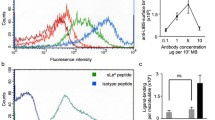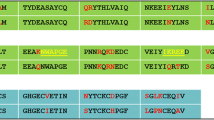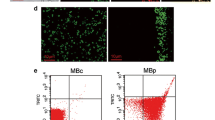Abstract
Proposed methods for detecting circulatory system disease include targeting ultrasound contrast agents to inflammatory markers on vascular endothelial cells. For antibody-based therapies, soluble forms of the targeted adhesion proteins of the immunoglobulin superfamily (IgSF) reduce adhesion yet were left unaccounted in prior reports. Microspheres labeled simply with a maximum level of antibodies can reduce the diagnostic sensitivity by adhering to proteins expressed normally at a low level, while sparsely coated particles may be rendered ineffective by circulating soluble forms of the targeted proteins. A new microdevice technique is applied to simultaneously measure the adhesion profile to a series of IgSF-protein-coated surfaces. In this investigation, we quantify the in vitro binding characteristics of 5-μm microspheres to oriented intercellular adhesion molecule-1 (ICAM-1) and vascular cell adhesion molecule-1 (VCAM-1) protein-coated surfaces in the presence of human serum at physiological concentrations. Defined regions of a slide were coated with recombinant chimeric Fc-human ICAM-1 and VCAM-1 in variable ratios but constant total concentration. Monoclonal human anti-ICAM-1 or anti-VCAM-1 antibodies in competition with non-binding mouse anti-rabbit antibodies coat the microsphere surface at a constant surface density with variable yet controlled surface activities. Using multiple slide surface IgSF protein and microsphere antibody concentrations, an adhesion profile was developed for the microspheres with and without IgSF proteins from human serum, which demonstrated that exposure to serum reduced microsphere binding, on average, more than 50% compared to the no-serum condition.. The serum effects were limited to antibodies on the microsphere, since binding inhibition was reversed after rinsing serum from the system and fresh antibody-coated microspheres were introduced. This analysis quantifies the binding effects of soluble IgSF proteins from human serum on antibody-based targeted ultrasound detection and drug delivery methods.







Similar content being viewed by others
References
Packard, R. R. S., & Libby, P. (2008). Clinical Chemistry, 54(1), 24–38. doi:10.1373/clinchem.2007.097360.
Wang, J. H., & Springer, T. A. (1998). Immunological Reviews, 163, 197–215. doi:10.1111/j.1600-065X.1998.tb01198.x.
Wickline, S. A., & Lanza, G. M. (2003). Circulation, 107(8), 1092–1095. doi:10.1161/01.CIR.0000059651.17045.77.
Jaffer, F. A., Libby, P., & Weissleder, R. (2007). Circulation, 116(9), 1052–1061. doi:10.1161/CIRCULATIONAHA.106.647164.
Rychak, J. J., Graba, J., Cheung, A. M. Y., Mystry, B. S., Lindner, J. R., Kerbel, R. S., et al. (2007). Molecular Imaging, 6(5), 289–296.
Klibanov, A. L. (2007). Journal of Nuclear Cardiology, 14(6), 876–884. doi:10.1016/j.nuclcard.2007.09.008.
Morawski, A. M., Winter, P. M., Crowder, K. C., Caruthers, S. D., Fuhrhop, R. W., Scott, M. J., et al. (2004). Magnetic Resonance in Medicine, 51(3), 480–486. doi:10.1002/mrm.20010.
Yoon, C. H., Hur, J., Oh, I. Y., Park, K. W., Kim, T. Y., Shin, J. H., et al. (2006). Arteriosclerosis, Thrombosis, and Vascular Biology, 26(5), 1066–1072. doi:10.1161/01.ATV.0000215001.92941.6c.
Sang Won Ham, A., Goetz, D. J., Klibanov, A. L., & Lawrence, M. B. (2007). Biotechnology and Bioengineering, 96(3), 596–607. doi:10.1002/bit.21153.
Weller, G. E., Villanueva, F. S., Klibanov, A. L., & Wagner, W. R. (2002). Annals of Biomedical Engineering, 30(8), 1012–1019. doi:10.1114/1.1513565.
Weller, G. E., Lu, E., Csikari, M. M., Klibanov, A. L., Fischer, D., Wagner, W. R., et al. (2003). Circulation, 108(2), 218–224. doi:10.1161/01.CIR.0000080287.74762.60.
Klibanov, A. L. (2006). Investigative Radiology, 41(3), 354–362. doi:10.1097/01.rli.0000199292.88189.0f.
Ottoboni, S., Short, R. E., Kerby, M. B., Tickner, E. G., Steadman, E., & Ottoboni, T. B. (2006). Contrast Media & Molecular Imaging, 1(6), 279–290. doi:10.1002/cmmi.115.
Meier, P., Vogt, B., & Blanc, E. (2007). Nephron. Experimental Nephrology, 105(1), e17–e23. doi:10.1159/000097015.
Omolola Eniola, A., & Hammer, D. A. (2005). Biomaterials, 26(34), 7136–7144. doi:10.1016/j.biomaterials.2005.05.005.
Astrof, N. S., Salas, A., Shimaoka, M., Chen, J., & Springer, T. A. (2006). Biochemistry, 45(50), 15020–15028. doi:10.1021/bi061566o.
Pepper, L. R., Hammer, D. A., & Boder, E. T. (2006). Journal of Molecular Biology, 360(1), 37–44. doi:10.1016/j.jmb.2006.04.049.
Smith, L. A., Aranda-Espinoza, H., Haun, J. B., & Hammer, D. A. (2007). Biophysical Journal, 92(2), 632–640. doi:10.1529/biophysj.105.079418.
Kuo, S. C., & Lauffenburger, D. A. (1993). Biophysical Journal, 65(5), 2191–2200.
Warren, T. G., Hippenmeyer, P. J., Meyer, D. M., Reitz, B. A., Rowold Jr., E., & Carron, C. P. (1994). Protein Expression and Purification, 5(5), 498–508. doi:10.1006/prep.1994.1069.
Hoskins, M. H., & Dong, C. (2006). Molecular & Cellular Biomechanics, 3(2), 79–87.
Kuo, S. C., Hammer, D. A., & Lauffenburger, D. A. (1997). Biophysical Journal, 73(1), 517–531.
Reinhardt, P. H., & Kubes, P. (1998). Blood, 92(12), 4691–4699.
Rothlein, R., Mainolfi, E. A., Czajkowski, M., & Marlin, S. D. (1991). Journal of Immunology (Baltimore, MD.: 1950), 147(11), 3788–3793.
Mitomo, H., Shigematsu, H., Kobatake, E., Furusawa, H., & Okahata, Y. (2007). Journal of Molecular Recognition, 20(2), 83–89. doi:10.1002/jmr.813.
Lind, L. (2003). Atherosclerosis, 169(2), 203–214. doi:10.1016/S0021-9150(03)00012-1.
Jun, C. D., Carman, C. V., Redick, S. D., Shimaoka, M., Erickson, H. P., & Springer, T. A. (2001). The Journal of Biological Chemistry, 276(31), 29019–29027. doi:10.1074/jbc.M103394200.
Wojcikiewicz, E. P., Abdulreda, M. H., Zhang, X., & Moy, V. T. (2006). Biomacromolecules, 7(11), 3188–3195. doi:10.1021/bm060559c.
Guray, U., Erbay, A. R., Guray, Y., Yilmaz, M. B., Boyaci, A. A., Sasmaz, H., et al. (2004). International Journal of Cardiology, 96(2), 235–240. doi:10.1016/j.ijcard.2003.07.014.
Acknowledgments
M.K. conceived, designed, and performed the experiments, analyzed data, and wrote the manuscript. J.U. performed experiments, analyzed data, and wrote the manuscript. L.M. performed experiments and analyzed data and contributed to the manuscript. A.T. conceived, designed, and performed experiments, analyzed data, and wrote the manuscript. Special thanks to Beth Smith and Paul Hartman at the General Clinical Research Center (GCRC) at Case Western Reserve for graciously analyzing the human serum lot used in this investigation for sICAM-1 concentration. We acknowledge the support of the Brown Startup Funds for this research.
Author information
Authors and Affiliations
Corresponding author
Rights and permissions
About this article
Cite this article
Kerby, M.B., Urban, J.C., Mouallem, L. et al. Circulating IgSF Proteins Inhibit Adhesion of Antibody Targeted Microspheres to Endothelial Inflammatory Ligands. Appl Biochem Biotechnol 159, 208–220 (2009). https://doi.org/10.1007/s12010-008-8474-y
Received:
Accepted:
Published:
Issue Date:
DOI: https://doi.org/10.1007/s12010-008-8474-y




